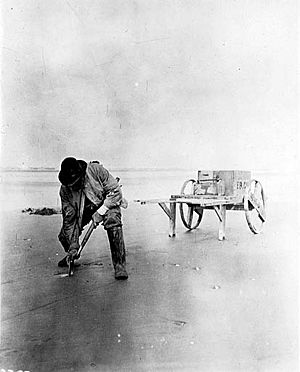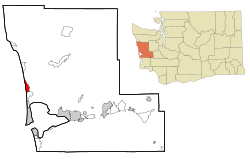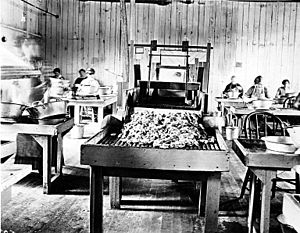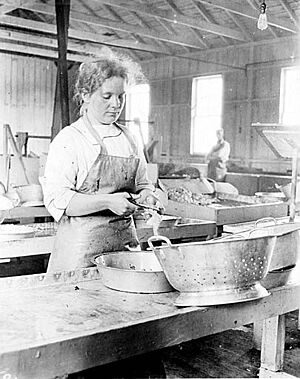Copalis Beach, Washington facts for kids
Quick facts for kids
Copalis Beach, Washington
|
|
|---|---|

Digging razor clams on the beach, 1915
|
|

Location of Copalis Beach, Washington
|
|
| Country | United States |
| State | Washington |
| County | Grays Harbor |
| Area | |
| • Total | 3.8 sq mi (9.8 km2) |
| • Land | 3.7 sq mi (9.6 km2) |
| • Water | 0.1 sq mi (0.3 km2) |
| Elevation | 23 ft (7 m) |
| Population
(2020)
|
|
| • Total | 447 |
| • Density | 117.6/sq mi (45.61/km2) |
| Time zone | UTC-8 (Pacific (PST)) |
| • Summer (DST) | UTC-7 (PDT) |
| ZIP code |
98535
|
| Area code(s) | 360 |
| FIPS code | 53-14660 |
| GNIS feature ID | 1530849 |
Copalis Beach is a small community located in Grays Harbor County, Washington, United States. It's known as a census-designated place (CDP), which means it's a special area defined for gathering population data. In 2020, about 447 people lived there.
The name "Copalis" comes from the Quinault language. It's related to the Copalis, a group of Native American people. Both the Chehalis people and Quinault Indian Nation say the Copalis are part of their larger tribes.
Contents
Discovering Copalis Beach's Location
Copalis Beach is found on the coast of Washington state. Its exact location is 47°7′4″N 124°10′42″W / 47.11778°N 124.17833°W.
The community covers a total area of about 3.8 square miles (9.8 square kilometers). Most of this area is land, about 3.7 square miles (9.6 square kilometers). A small part, 0.1 square miles (0.3 square kilometers), is water.
Population Changes in Copalis Beach
The number of people living in Copalis Beach has changed over the years. Here's a quick look at the population counts:
| Historical population | |||
|---|---|---|---|
| Census | Pop. | %± | |
| 2000 | 489 | — | |
| 2010 | 415 | −15.1% | |
| 2020 | 447 | 7.7% | |
| U.S. Decennial Census | |||
In 2000, there were 489 people living in Copalis Beach. This included 232 households, which are groups of people living together. Many of these were families.
The population included people of different ages. About 19.6% were under 18 years old. Many residents were older, with 23.5% being 65 years or older. The average age in Copalis Beach was 49 years old.
A Glimpse into Copalis Beach History
Early Inhabitants: The Copalis Native Americans
The Copalis Native Americans lived in this area for a long time. They were part of the Salishan language family. Their traditional lands included the Copalis River and the Pacific Coast.
In 1805, explorers Lewis and Clark estimated that about 200 Copalis people lived in the area. They lived in about 10 houses.
Settlement and the Famous Razor Clams
The first non-Native American settlers arrived in Copalis Beach in the 1890s. Soon, Copalis Beach became famous for its amazing razor clams. Many people say it has one of the best razor clam beds in the world. These clams are known for their great flavor.
Razor clams are found mainly in the Pacific Northwest. Copalis Beach is a particularly good spot for them. During the clam digging season, the population of Copalis Beach would grow a lot. It would sometimes become four times larger than its usual size of about 350 people.
In 1947 and 1948, commercial clam diggers collected over a million pounds of clams from Copalis Beach. This brought a lot of money to the community and to the people who worked in the clam canneries. Tourists also enjoyed digging for thousands of pounds of clams.
See also
 In Spanish: Copalis Beach (Washington) para niños
In Spanish: Copalis Beach (Washington) para niños




